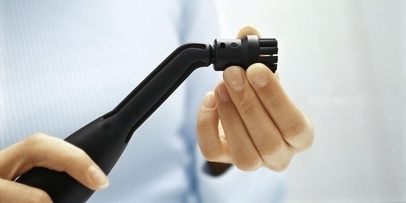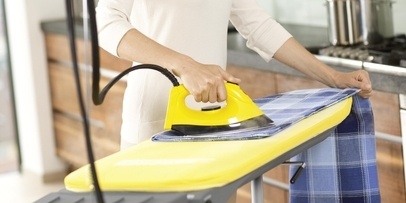Steam cleaner applications
It's full steam ahead against dirt! A steam cleaner allows you to clean almost all of your household surfaces in a way that is thorough, hygienic and eco-friendly – right down to the smallest crevice. And as no cleaning agents are needed, you can say goodbye to streaks. No lime residues are left either, as the water is demineralised during steam generation.
Removing grease deposits

1. Stainless steel is all the rage – but it only looks good without greasy deposits. Particularly good results can be achieved with the soft velour cover and yellow microfibre cloth (special accessories) from the microfibre kitchen cloth kit.

2. If the grease has already been there a while, steady scrubbing and pressing is the only solution. Always apply steam whilst doing so.

3. The grease will slowly accumulate on the cloth. The cloth should therefore be changed occasionally.

4. The surface is then cleaned one section at a time: the nozzle in one hand and the fresh cloth in the other.
Cleaning crevices

1. The detail nozzle is suited to targeted cleaning of tile crevices, and a round brush can be attached if necessary.

2. Even stubborn, dried-on dirt can be removed by applying direct steam and scrubbing vigorously.

3. After steam cleaning, the surface can be rubbed dry using a cloth. Note for silicone grouting: apply steam only briefly to avoid damaging the material.
Cleaning hobs and cookers

1. Glass-ceramic hobs are a problem zone for many cleaning methods – but not for steam cleaners. A stainless steel spiral scourer is attached to the round brush. These are available in any homeware store.

2. There's no need to worry about scratches on the glass hob when steam is involved. The steam forms a kind of lubricating layer during cleaning. Crevices and edges of the hob can be cleaned using the detail brush without the cover.
Cleaning fittings

1. Use the detail nozzle exclusively to avoid scratching chrome or stainless steel fittings. Hold it close to the object being cleaned and wait until the limescale breaks down. If it still won't budge or is in an awkward spot, the nozzle can be fitted with a brush. Scrub the area whilst applying powerful blasts of steam.

2. Thicker layers of limescale should first be doused in vinegar and left to soak for around five minutes.
Cleaning windows with the window nozzle

1. Before first using a steam cleaner, carry out a deep clean: wipe over the whole surface with a steam cloth and the manual nozzle and wipe over with a dry cloth.
Tip for winter: warm up very cold panes beforehand from a distance of around 5 cm.

2. Apply steam to the glass surface using the window nozzle and scrape from top to bottom with the window nozzle's squeegee.

3. If cleaning windows from the outside, bear in mind that steam cleaners are indoor products and should not be used outdoors for safety reasons! As can be seen in the picture, this problem can be solved.

4. Subsequent window cleaning will be much simpler after this initial clean: the entire surface is cleaned both inside and out using the window nozzle in strips of 10 cm, starting from the top and working downwards.

5. Scrape the window in strips using the squeegee, starting at the top and working down – and once more crosswise when you reach the bottom. To avoid the formation of streaks, wipe off the squeegee periodically using a cloth.

6. If a few drops remain on the pane after using the squeegee – not a problem. They can be wiped off easily and without streaks using the cloth.
Cleaning windows with the point jet and squeegee

1. Same as for cleaning with the window nozzle: first carry out deep cleaning.

2. Then, apply steam to the glass surface from top to bottom using the detail nozzle.

3. Scrape the condensed water downwards in multiple passes using the squeegee.

4. Finally, simply soak up the moisture with a cloth - done!
Cleaning tile floors

1. For intermediate cleaning and postcleaning, please use a cloth that you can fold over and stretch tightly over the floor nozzle. You can also use the microfibre cloth (special accessory) for particularly thorough cleaning.

2. Move the nozzle quickly back and forth after releasing the steam; you do not have to keep releasing steam continuously. To clean crevices, you should not only move the nozzle at right angles to, but also
diagonally to the crevice.
Cleaning laminate flooring

1. With a steam cleaner with steam volume control (lowest setting), you can also clean laminate or parquet flooring (not oiled or waxed!). Work with two cloths (= 4 layers), so that as little steam as possible comes in direct contact with the area.

2. Only use the SC 1702 in steam mode and do not apply steam to the same spot for too long. Please ensure no puddles of water form. The residual moisture
will then dry up quickly and without streaks.
Ironing

1. Set your steam iron to the maximum temperature when ironing with steam. Continual steam output prevents your laundry from being overheated – whether cotton, silk or linen.

2. Non-stick iron soleplate as a special accessory: prevents shiny patches on delicate and dark materials (e.g. linen). T-shirts with transfers no longer need to be ironed inside out.

3. The steam pressure is so high that even thick jeans only need ironing from one side. Slowly glide the steam iron across the fabric applying light pressure and the steam pressure will do the work for you.
Freshening up clothing

1. Even freshening up clothes is effortless with the additional textile care nozzle. Creases in curtains and clothes can be simply ironed out without having to place the fabric onto an ironing board. Odours are also reliably removed. A weight off your shoulders!

2. The integrated lint remover removes hairs and lint from clothes effortlessly.

